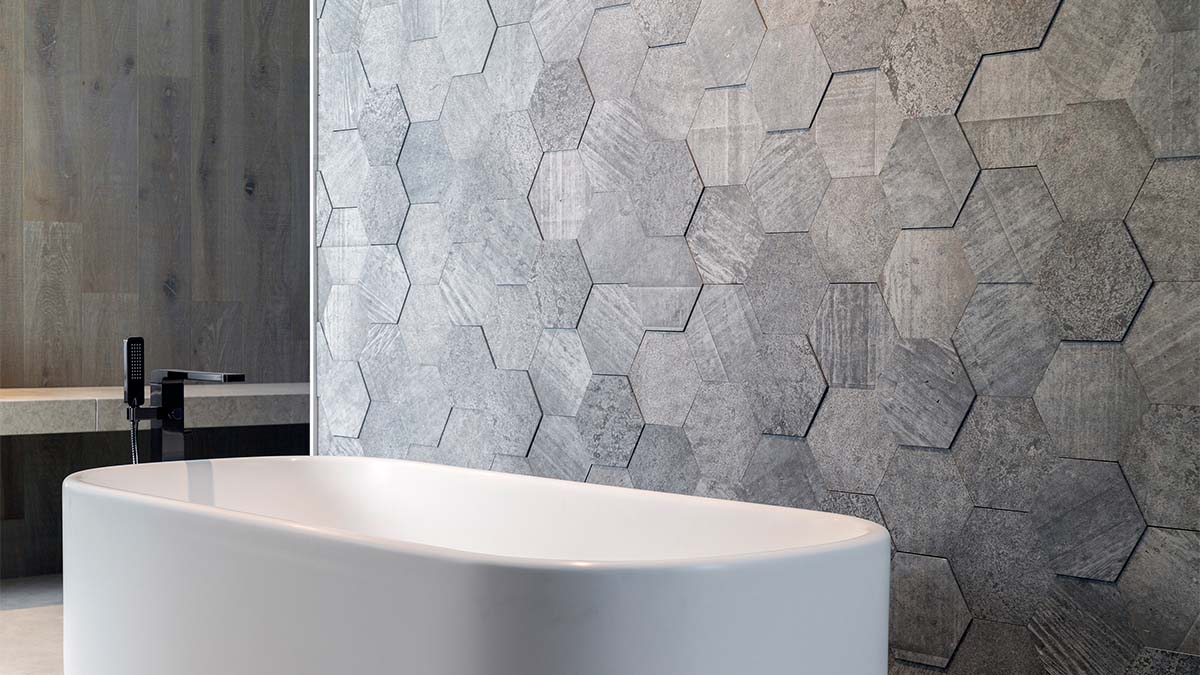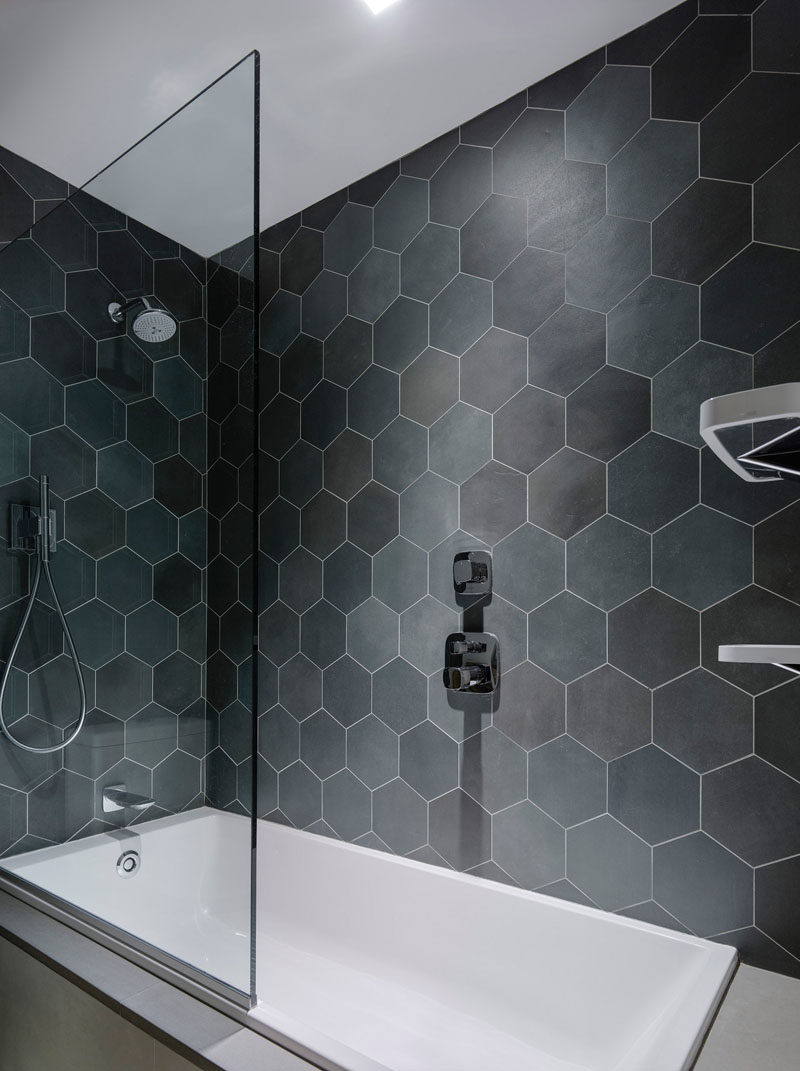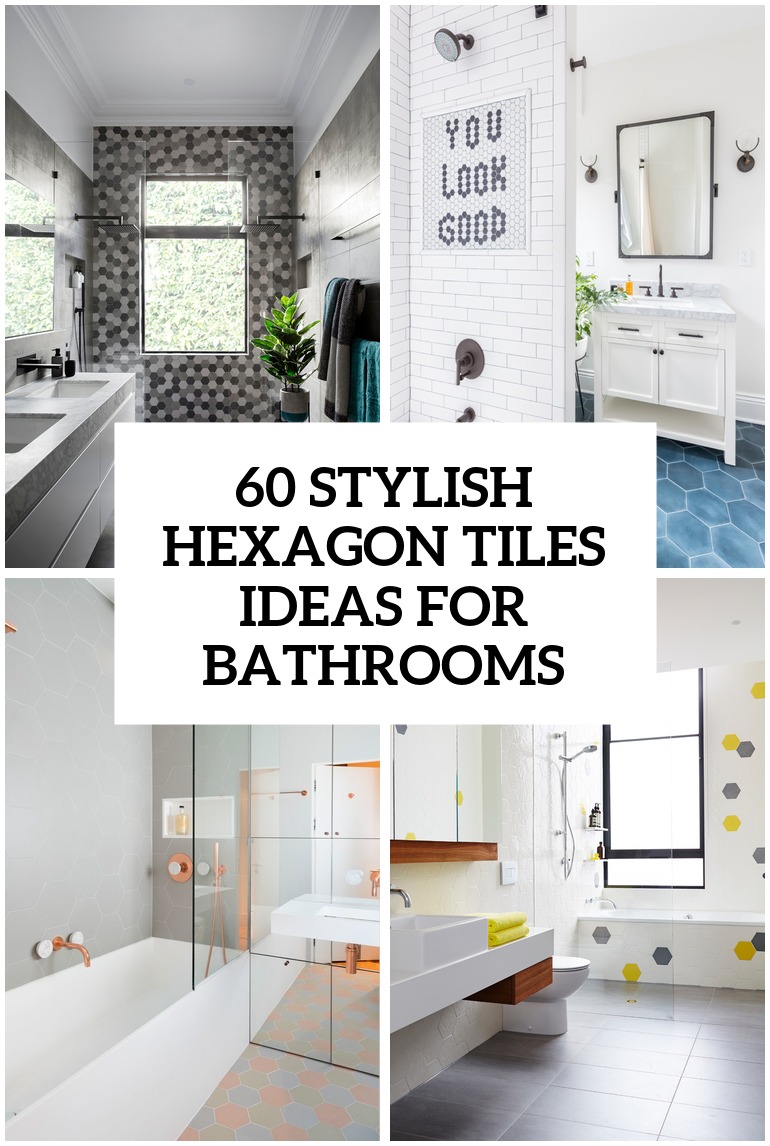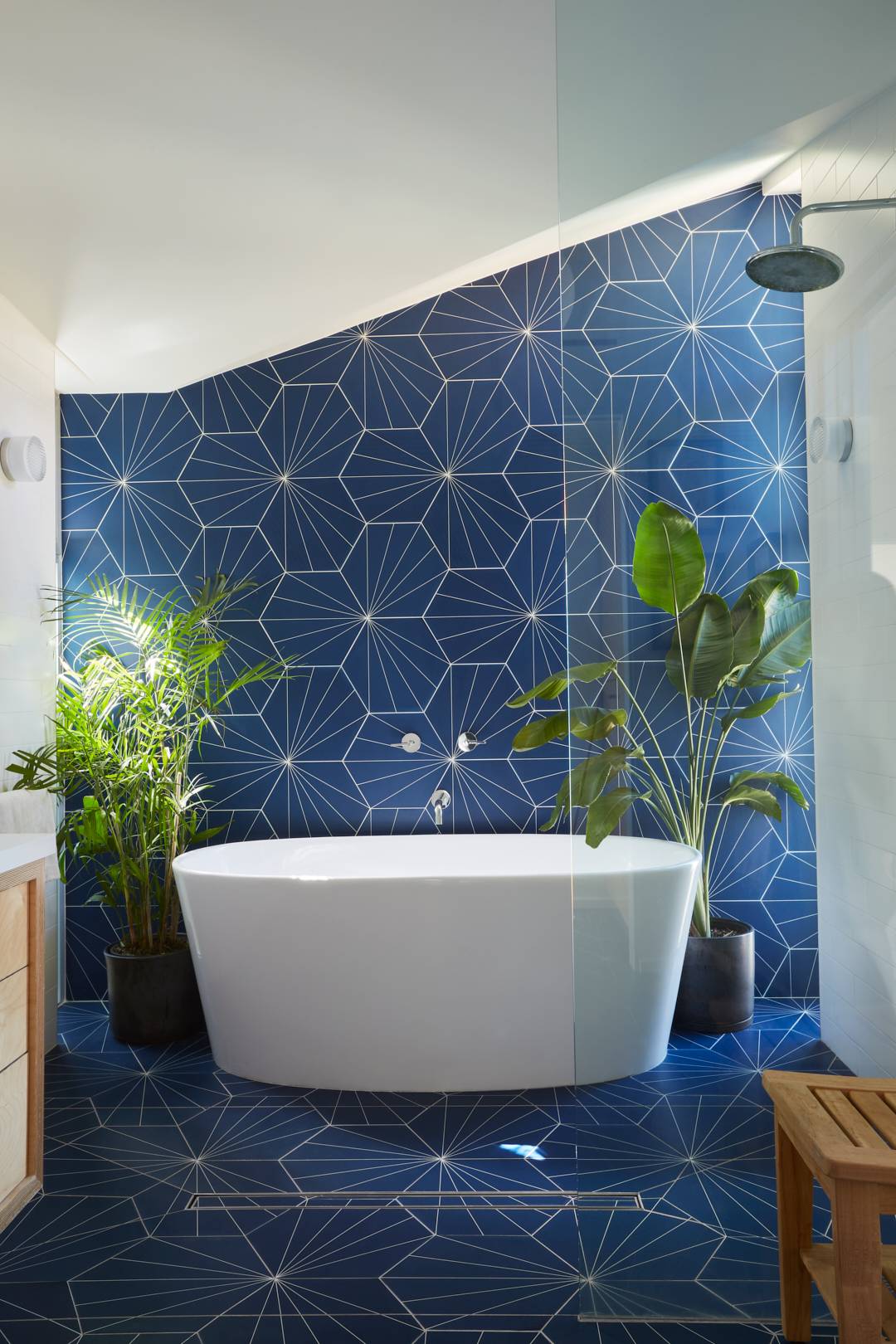Bathroom Tiles Hexagon: A Modern Twist on a Classic Shape
Hexagon tiles have emerged as a popular choice for modern bathrooms, offering a fresh and contemporary twist on a classic shape. With their geometric allure and versatility, hexagonal tiles have become a go-to option for homeowners and designers looking to elevate the aesthetic appeal of bathroom spaces. Let’s talk more about bathroom tiles hexagons and why they have become a staple in modern interior design.
- Geometric Sophistication: Hexagon tiles bring a sense of geometric sophistication to bathroom spaces, adding visual interest and depth to walls and floors. The six-sided shape creates a unique tessellating pattern that can be arranged in various layouts to suit different design preferences. Whether used as a subtle accent or a bold statement, hexagonal tiles infuse bathrooms with a modern and stylish aesthetic that transcends trends.
- Endless Design Possibilities: One of the key advantages of hexagon tiles is their versatility in design. From classic monochrome schemes to vibrant geometric patterns, the design possibilities are virtually endless with hexagonal tiles. Whether you prefer a timeless and understated look or a bold and eclectic style, hexagon tiles can be customized to reflect your taste and creativity, making them a versatile choice for any bathroom renovation project.
- Enhanced Visual Impact: The distinctive shape of hexagon tiles lends itself well to creating visual impact in bathroom spaces. Whether used as a feature wall, shower surround, or flooring option, hexagonal tiles command attention and draw the eye with their unique geometry. By playing with scale, color, and layout, homeowners and designers can create dynamic and visually engaging compositions that elevate the overall look and feel of the bathroom.
- Modern Interpretation of Tradition: While hexagon tiles have a rich history dating back centuries, their resurgence in contemporary interior design reflects a modern interpretation of tradition. By reimagining this classic shape in sleek and sophisticated materials such as porcelain, ceramic, or marble, designers have transformed hexagonal tiles into a symbol of modernity and innovation. This blend of timeless elegance and contemporary flair makes hexagon tiles a perfect fit for modern bathrooms seeking a balance between tradition and innovation.
- Seamless Integration with Other Materials: Hexagon tiles seamlessly integrate with a wide range of materials and finishes, allowing for endless design combinations in the bathroom. Whether paired with natural stone, wood, or metallic accents, hexagonal tiles add texture, depth, and visual interest to the space, creating a cohesive and harmonious design scheme. Their ability to complement and enhance other materials makes hexagon tiles a versatile choice for creating cohesive and visually appealing bathroom interiors.
- Timeless Appeal: Despite their modern aesthetic, hexagon tiles possess a timeless appeal that ensures they will never go out of style. Unlike trendy design elements that may quickly become outdated, hexagonal tiles have stood the test of time and continue to be a popular choice for bathrooms across the globe. Their enduring popularity is a testament to their versatility, durability, and ability to adapt to evolving design trends, making them a wise investment for any bathroom renovation project.

Why Hexagon Tiles Are Ideal for Bathroom Flooring and Walls
Hexagon tiles have become a popular choice for bathroom flooring and walls, thanks to their versatility, durability, and aesthetic appeal. With their unique shape and timeless charm, hexagonal tiles offer numerous benefits that make them an ideal option for both practical and decorative purposes in the bathroom. Let’s find out why hexagon tiles are perfect for enhancing the flooring and walls of bathroom spaces.
Sleek and Modern Aesthetic: Hexagon tiles bring a sleek and modern aesthetic to bathroom interiors, adding a touch of contemporary elegance to the space. The six-sided shape creates a visually striking pattern that instantly elevates the look and feel of the bathroom, transforming it into a stylish and sophisticated retreat. Whether used as flooring or wall coverings, hexagonal tiles infuse bathrooms with a sense of design flair and personality that sets them apart from traditional square or rectangular tiles.
Versatile Design Options: One of the key advantages of hexagon tiles is their versatility in design, offering endless possibilities for customization and creativity in the bathroom. From classic monochrome schemes to bold geometric patterns, hexagonal tiles can be arranged in various layouts to suit different design preferences and aesthetic tastes. Whether you prefer a subtle and understated look or a bold and dramatic statement, hexagon tiles can be tailored to reflect your unique style and vision for the space.
Enhanced Visual Interest: The distinctive shape of hexagon tiles adds visual interest and depth to bathroom floors and walls, creating a dynamic and engaging environment. Unlike traditional square or rectangular tiles, which can appear flat and uninspired, hexagonal tiles command attention with their geometric allure and tessellating patterns. By playing with scale, color, and texture, homeowners and designers can create visually stunning compositions that transform the bathroom into a work of art.
Seamless Installation: Despite their intricate appearance, hexagon tiles are relatively easy to install, making them a practical choice for bathroom flooring and walls. Their uniform shape and size allow for seamless installation with minimal grout lines, resulting in a clean and cohesive finish that enhances the overall aesthetic of the space. Whether installed in a classic grid pattern or a more intricate design, hexagonal tiles create a sense of continuity and flow that enhances the visual appeal of the bathroom.
Durable and Easy to Maintain: Hexagon tiles are known for their durability and low-maintenance properties, making them an ideal option for high-traffic areas such as bathrooms. Made from sturdy materials such as porcelain, ceramic, or natural stone, hexagonal tiles are resistant to scratches, stains, and water damage, ensuring long-lasting performance in the bathroom. Additionally, their smooth and non-porous surface makes them easy to clean and maintain, requiring only regular sweeping and mopping to keep them looking pristine.
Timeless Elegance: Despite their contemporary appeal, hexagon tiles possess a timeless elegance that ensures they will never go out of style. Unlike trendy design elements that may quickly become outdated, hexagonal tiles have a classic charm that transcends passing fads and trends, making them a wise investment for any bathroom renovation project. Their enduring popularity and versatility make hexagon tiles a timeless choice for enhancing the flooring and walls of bathroom spaces.
Installation Tips and Techniques for Achieving Stunning Results
Installing hexagonal tiles in the bathroom requires careful planning and attention to detail to ensure a seamless and professional finish. While the unique shape of hexagon tiles can present some challenges during installation, following the right tips and techniques can help you achieve stunning results that enhance the beauty and functionality of your bathroom space. Below are some essential installation tips and techniques for working with hexagonal tiles in the bathroom.
Proper Surface Preparation: Before installing hexagonal tiles, it’s essential to prepare the surface properly to ensure a secure and long-lasting bond. Start by cleaning the substrate thoroughly to remove any dirt, dust, or debris that may affect adhesion. Repair any cracks, holes, or uneven areas in the substrate using a suitable patching compound or filler. Additionally, apply a primer or bonding agent to promote adhesion and prevent moisture infiltration, especially in wet areas such as shower enclosures.
Layout Planning: Plan the layout of the hexagonal tiles carefully to achieve a balanced and visually pleasing design. Consider factors such as tile size, room dimensions, and architectural features when determining the layout. Dry-lay the tiles on the floor or wall to experiment with different arrangements and patterns before committing to installation. Pay attention to the placement of cut tiles and ensure they are evenly distributed throughout the space to maintain symmetry and continuity in the design.
Choosing the Right Adhesive: Selecting the appropriate adhesive is crucial for ensuring a strong and durable bond between the hexagonal tiles and the substrate. Choose a high-quality, polymer-modified thin-set mortar that is suitable for the specific tile material and substrate conditions. Follow the manufacturer’s instructions for mixing and applying the adhesive, ensuring proper coverage and adhesion to prevent tile slippage or delamination during installation.
Tile Installation: Begin by applying a thin layer of adhesive to the substrate using a notched trowel, ensuring consistent coverage and thickness. Press the hexagonal tiles firmly into the adhesive, using tile spacers to maintain uniform spacing between tiles. Work in small sections, gradually building outwards from the center of the installation area to the edges. Use a rubber mallet or wooden block to gently tap the tiles into place and ensure they are level and flush with adjacent tiles.
Grouting: Once the tiles are installed and the adhesive has cured according to the manufacturer’s recommendations, it’s time to grout the joints. Choose a grout color that complements the tiles and enhances the overall aesthetic of the bathroom. Mix the grout to the proper consistency and apply it to the joints using a grout float, pressing it firmly into the gaps to ensure full coverage. Use a grout sponge to remove excess grout from the tile surfaces and smooth the joints, working diagonally to avoid disturbing the grout lines.
Sealing: Depending on the tile material and grout used, sealing may be necessary to protect the surfaces from moisture, stains, and damage. Apply a penetrating sealer to the tiles and grout according to the manufacturer’s instructions, ensuring complete coverage and absorption into the porous surfaces. Allow the sealer to dry completely before using the bathroom, and reapply as needed to maintain protection and longevity.
Finishing Touches: Once the installation is complete and the grout has dried, take the time to inspect the work and make any necessary touch-ups or adjustments. Clean the tile surfaces thoroughly to remove any remaining grout residue or haze, using a damp sponge or cloth. Seal any visible gaps or cracks with caulk to prevent water infiltration and maintain a clean and finished appearance. Finally, admire your handiwork and enjoy the stunning results of your hexagonal tile installation in the bathroom.
Creative Patterns and Layouts
Hexagon tiles offer endless possibilities for creative patterns and layouts that can transform the look and feel of your bathroom space. Whether you’re aiming for a classic, timeless design or a bold, contemporary statement, hexagonal tiles allow you to unleash your creativity and personalize your bathroom to reflect your unique style. Here are some inspiring patterns and layouts for using hexagon tiles in the bathroom to achieve stunning results.
Classic Grid Pattern: The classic grid pattern is a timeless layout option that showcases the geometric beauty of hexagonal tiles. Arrange the tiles in straight rows and columns, with each hexagon aligned with the adjacent ones to create a uniform grid pattern. This simple yet elegant layout is perfect for both floor and wall applications and complements a wide range of design styles, from traditional to modern.
Offset or Staggered Pattern: For a more dynamic and visually interesting look, consider using an offset or staggered pattern with hexagonal tiles. This layout involves shifting each row of tiles slightly to the side, creating a subtle zigzag effect that adds movement and depth to the design. The offset pattern is ideal for adding visual interest to large expanses of flooring or creating eye-catching accent walls in the bathroom.
Hexagonal Mosaic: Create a stunning focal point in the bathroom with a hexagonal mosaic design using small hexagon tiles in different colors or finishes. Arrange the tiles in a mosaic pattern, such as a floral motif, geometric pattern, or random arrangement, to create a one-of-a-kind feature wall or shower surround. The intricate detailing and subtle variations in color and texture add texture and dimension to the space, creating a sense of luxury and sophistication.
Diagonal Layout: Break away from the traditional grid pattern and opt for a diagonal layout with hexagonal tiles to add a sense of movement and drama to the bathroom. Install the tiles at a 45-degree angle to the walls or floor, creating a diamond-shaped pattern that draws the eye and makes a bold statement. The diagonal layout is ideal for small bathrooms or narrow spaces, as it creates the illusion of more space and adds visual interest to the room.
Herringbone or Chevron Pattern: Add a touch of elegance and sophistication to your bathroom with a herringbone or chevron pattern using hexagon tiles. Arrange the tiles in a zigzag pattern, with each tile positioned at a 45-degree angle to create a series of interlocking V shapes. The herringbone or chevron pattern adds visual interest and texture to the walls or floors, creating a stylish and dynamic backdrop for the rest of the bathroom decor.
Graduated Color Gradient: Experiment with color and texture by creating a graduated color gradient with hexagonal tiles in varying shades or finishes. Start with a dark hue at one end of the bathroom and gradually transition to a lighter shade or vice versa, creating a subtle ombre effect that adds depth and dimension to the space. The graduated color gradient can be applied to both floor and wall applications, allowing you to customize the look of your bathroom to suit your personal style and preferences.
Choosing the Right Hexagonal Tiles for Your Bathroom
When it comes to bathroom renovation, choosing the right materials is essential for achieving both aesthetic appeal and functionality. Hexagonal tiles have become a popular choice for bathroom flooring and walls due to their versatility, durability, and timeless appeal. However, with a wide range of materials available, selecting the right hexagonal tiles for your bathroom renovation can be overwhelming. Below are some popular material options for hexagon tiles and help you choose the right one for your bathroom project.
Porcelain: Porcelain hexagon tiles are a popular choice for bathroom renovations due to their durability, water resistance, and versatility. Made from dense clay fired at high temperatures, porcelain tiles are highly durable and resistant to scratches, stains, and moisture, making them ideal for wet areas such as bathrooms. Porcelain hexagon tiles are available in a wide range of colors, finishes, and textures, allowing you to customize the look of your bathroom to suit your style and preferences. Whether you prefer a sleek and modern aesthetic or a more traditional and timeless look, porcelain hexagon tiles offer endless possibilities for creating stunning and functional bathroom spaces.
Ceramic: Ceramic hexagon tiles are another popular option for bathroom renovations, offering a budget-friendly alternative to porcelain tiles. Like porcelain, ceramic tiles are made from clay fired at high temperatures, but they are less dense and more porous, making them slightly less durable and water-resistant. However, ceramic hexagon tiles are still suitable for bathroom use, especially in low-traffic areas such as walls or backsplashes. Ceramic tiles come in a variety of colors, patterns, and finishes, allowing you to achieve the desired look for your bathroom renovation project without breaking the bank.
Marble: For a luxurious and elegant look, consider using marble hexagon tiles in your bathroom renovation. Marble is a natural stone prized for its timeless beauty, unique veining, and rich color variations, making it a popular choice for high-end residential and commercial projects. Marble hexagon tiles add a touch of sophistication and luxury to bathroom spaces, creating a stunning focal point that elevates the overall aesthetic of the room. While marble is more expensive than porcelain or ceramic, its timeless appeal and durability make it a worthwhile investment for homeowners seeking to create a luxurious and stylish bathroom retreat.
Glass: Glass hexagon tiles are a modern and stylish option for adding a pop of color and texture to your bathroom renovation. Glass tiles are available in a wide range of vibrant colors, translucent finishes, and iridescent effects, allowing you to create a custom look that reflects your personal style and taste. Glass hexagon tiles are non-porous and resistant to moisture, making them suitable for use in wet areas such as showers or backsplashes. Their reflective properties also help to brighten and open up small bathroom spaces, creating a sense of lightness and airiness.
Natural Stone: Natural stone hexagon tiles, such as travertine, slate, or limestone, add warmth, texture, and character to bathroom spaces. Each type of natural stone has its unique color variations, veining, and surface textures, creating a one-of-a-kind look that cannot be replicated with synthetic materials. Natural stone hexagon tiles are durable, timeless, and resistant to wear and tear, making them an excellent choice for high-traffic areas such as bathroom floors or shower surrounds. While natural stone tiles may require sealing and regular maintenance to prevent staining and moisture damage, their natural beauty and enduring appeal make them a popular choice for homeowners seeking to create a rustic, organic, or earthy aesthetic in their bathroom renovation.
Mixed Materials: For a truly unique and personalized look, consider using hexagon tiles made from a combination of materials, such as porcelain and glass, or ceramic and marble. Mixed-material hexagon tiles offer the best of both worlds, combining the durability and versatility of synthetic materials with the natural beauty and elegance of stone or glass. Mix and match different materials, colors, and finishes to create custom patterns and designs that reflect your style and personality. Whether you prefer a contemporary, eclectic, or minimalist aesthetic, mixed-material hexagon tiles allow you to create a one-of-a-kind bathroom space that stands out from the crowd.
Denim Hexagon Tile Blue Honeycomb Ceramic Tile u2013 Mercury Mosaics
Stylish Hexagon Tiles Ideas For Bathrooms
Hexagon Porcelain Tile For Bathroom
Hexagon Floor Tiles Hexagon Tile For Your Kitchen or Bathroom
Monet 3″ x 3″ Calacatta Porcelain Hexagon Mosaic Tile
Hexagon Stainless Steel Brushed Mosaic Tile Bronze Copper Color Black Bathroom Shower Floor Tiles TSTMBT021 (10 Square Feet)
Hexagon Bathroom Tile Ideas: From Floors to Shower Walls
Tile School: How to Choose The Right Hexagon Tileu2026 Fireclay Tile
Related Posts:











